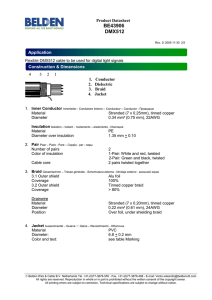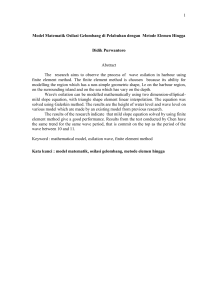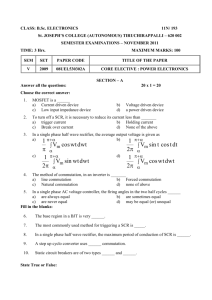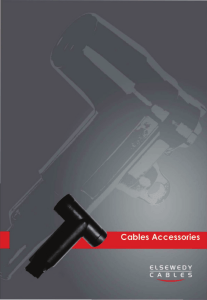Coaxial Cable: It`s not just a piece of wire.
advertisement
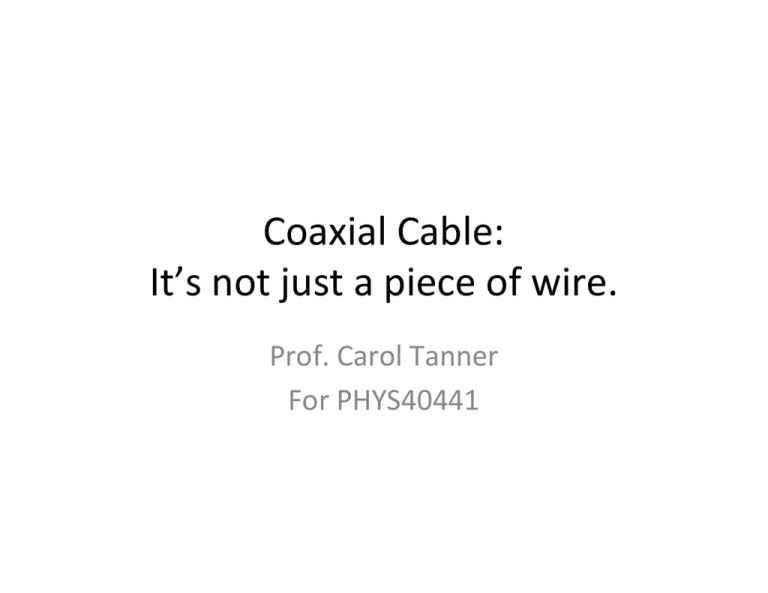
Coaxial Cable: It’s not just a piece of wire. Prof. Carol Tanner For PHYS40441 Coaxial Cable Coaxial cable From Wikipedia, the free encyclopedia Capacitance and Inductance per Unit Length D d ! = permativity of material µ = permeability of material h Typically derived in your basic physics text. From Wikipedia, the free encyclopedia SchemaMc RepresentaMon Coaxial cable From Wikipedia, the free encyclopedia L=total inductance C= total capacitance R= total resistance (small –> zero) G= total leakage resistance (very large –> infinite) L C Simplified SchemaMc This is not a very good model of a transmission line. Reminders from Basic Physics Courses For AC circuits: Vdrop = RI ZR = R Q Vdrop = C dI Vdrop = L dt V=Z I 1 ZC = j! C Z L = j! L I V Z V Z= I Derive the Capacitance of a Cylinder r d D Q = charge on the inner conductor ! h Used Gauss’ Law and an imaginary surface to calculate the E field in the cylinder. Voltage difference is the integral of the E field. Q = CV µ ! ! Q ! E i da = " r2 Q E2! rh = " E= D/2 Q ! 2" rh Q 1 Q Q % D( V = ! E dr = dr = ln(D / 2) $ ln(d / 2) = ln [ ] '& *) ! " 2 # h r " 2 # h " 2 # h d r1 d/2 C= Q 2!" h = # D& V ln % ( $d' C 2!" = h ln(D / d) Derive the Inductance of a Cylinder ! B I = current on the inner conductor r D d ! µ h • Used Ampere’s Law µI ! ! B = and an imaginary path B2! r = µ I B i d " = µI # ! 2! r to calculate the B field r2 in the cylinder. ! ! D/2 µ I µI µI % D( ! = B i d a = h dr = h ln(D / 2) $ ln(d / 2) = h ln [ ] '& *) • Determine the flux "r " 2# r 2 # 2 # d d/2 through the imaginary 1 loop. d" dI * µ $ D ' - dI Vdrop = !EMF = = L = ,h ln & ) / % d ( . dt dt dt 2 # + • Inductance is proporMonal µ " D% L µ " D% to the induced EMF for a L=h ln $ ' = ln $ ' change in current. 2! # d & h 2! # d & CharacterisMc Impedance of a Coaxial Cable L h L Z0 = = = C h C µ ln(D / d) 1 2! = 2!" 2! ln(D / d) 1 v= µ! c= Speed of EM wave in a medium. Index of RefracMon c = v 1 µ0! 0 = 1 µ! µ ln(D / d) " 1 µ0! 0 Speed of EM wave in a vacuum. µ ! µ0 ! 0 Common Types What it is the characterisMc impedance of a transmission line? L /h C /h We need a be`er model! L /h C /h L /h C /h L /h C /h L /h C /h … … x I1 V1 V2 I2 dQ dt L dI "x h dt !V = V (x2 ) " V (x1 ) !V L dI1 =" !x h dt V =0 !x V1 ! V2 = !V #V L dI = =$ !x"0 !x #x h dt lim I1 ! I 2 = dQ C dV = "x 2 dt h dt !I = I (x2 ) " I (x1 ) !I C dV2 =" !x h dt !I #I C dV = =$ !x"0 !x #x h dt lim Two Coupled Diff. Eq.s Solve for voltage and current. !V L dI =" !x h dt !I C dV =" !x h dt ! !V L d !I L C d dV =" ="" !x !x h dt !x h h dt dt Wave EquaMon ! 2 V # L C & d 2V "% =0 ( !x 2 $ h h ' dt 2 Find the current for a posiMve going wave. I=! Traveling wave soluMon for V V = Aei(kx!" t ) k2 = ! 2 LC h h k = ±! LC h h ! =v= k dI 1 "V 1 =! =! ikAei(kx!# t ) dt L / h "x L /h dI 1 1 "ik i(kx"# t ) 1 dt = " ikA ! ei(kx"# t ) dt = Ae = dt L /h L / h "i# L /h I (x,t) = C / h i(kx!" t ) Ae L /h L C i(kx"# t ) Ae h h 1 LC h h What voltage and current do we use to calculate the characterisMc impedance? The voltage and current at any parMcular point along the transmission line. I (x,t) V (x,t) Assume V = 0 on the outside conductor. V (x,t) Z0 = = I(x,t) Aei(kx!" t ) L /h L = = C /h C C / h i(kx!" t ) Ae L /h v= 1 1 = LC µ! h h DemonstraMon
